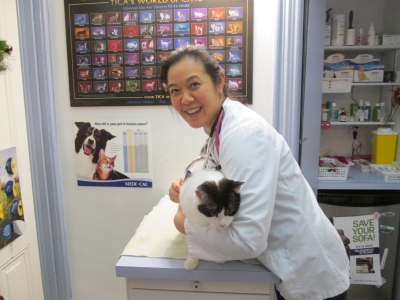Kidney disease is very common in cats and is the main reason that people start giving SQ fluids. The cat’s kidneys aren’t conserving water like they should – it just flows right through the body without being absorbed (which is why the urine is very dilute and not concentrated at all!). It’s also the reason that your cat may be drinking large amounts of water and urinating large amounts as well – the body knows it’s dehydrated and tried to compensate by telling the cat that he/she’s thirsty. Eventually, the kidney insufficiency turns to kidney failure and they shut down. But if hydrating fluids are supplemented, cats with renal problems may live many, many years beyond what they would without regular fluid treatment. By being willing to give your cat SQ fluids at home, you are essentially giving your cat more life.
The following is meant to be a guideline to start fluid treatment at home. If you have any specific questions, they should be directed to the veterinarian or technician. We are happy to do a demonstration or even watch and talk you through giving the fluids yourself, so you know you’re doing them correctly.
BEFORE STARTING
GETTING FAMILIARIZED WITH THE EQUIPMENT
- One unopened 1000ml bag of Lactated Ringers or Plasma Lyte A solution that has a white stopper in the bottom with a pull tab. The bag is marked in increments of 100ml (for example, from the number 1 to 2 is 100ml). There are unnumbered marks for 50ml in between each number.
- One 21 gauge butterfly catheter. There will be a small plastic cover over the needle.
- Needle – this is typically an 18 gauge needle that is used to withdraw the fluids out of the bag and into the syringe.
- Two 60ml syringes.
- Cotton ball with rubbing alcohol.
ASSEMBLING THE BUTTERFLY CATHETER
- Attach the 18 gauge needle to the 60ml syringe.
- Locate the injection port on the bag of fluids (soft, white/cream rubber stopper). Using the cotton ball with alcohol, swab the port. This will help to prevent contamination.
- Remove the plastic cap from the needle and place the tip of the needle in the injection port. The needle must be instereted into the centre of the rubber stopper. The injection port itself is held so the needle is inserted straight into the injection port to prevent needle stick injury.
- Draw back on the syringe plunger while holding the syringe barrel steady so the needle does not pull out of the fluid bag. Fill the syringe to the volume prescribed by the veterinarian.
- Remove the 18 gauge needle and replace it with the 21 gauge butterfly catheter. It is important to use a new butterfly catheter each time as the used one is now dull and contaminated.
GIVING YOUR CAT SQ FLUIDS
- Have everything ready and in place before getting you cat.
- With your cat resting in a comfortable position (on your lap or on a raised surface such as a countertop or table top), hold up a “tent” of skin in the scruff area behind the shoulders. It works well to have your cat facing away from you, so if he/she tries to back up, he/she will just back up into you.
- Insert the butterfly needle at a 45 degree angle in one quick motion into the tissue under the skin. You can advance the needle into the skin all the way up to the hub of the needle.
- Before injecting the fluid, pull back on the plunger of the syringe. If air bubbles appear in the syringe, the needle has gone through both folds of skin and you are sucking room air into the syringe. Pull the needle back slightly and try to reposition the needle or remove the needle completely and try again. If blood appears in the syringe, you have hit a blood vessel. Remove the needle and try again.
- Once you have checked that the needle is correctly placed, push the plunger to inject the fluids. The plunger can be pushed using one hand by holding the syringe between the index finger and the middle finger and pushing the plunger with the thumb of the same hand. If this is difficult, hold the syringe in one hand and push the plunger with the other. If you handle the syringe with one hand, your other hand is free to comfort or restrain your cat.
- TROUBLESHOOTING: If the fluids are not flowing, first check to make sure that the line is free of “kinks”.If the fluids are still not flowing, redirect your needle slightly, either by pushing it in further or pulling it out a little.


